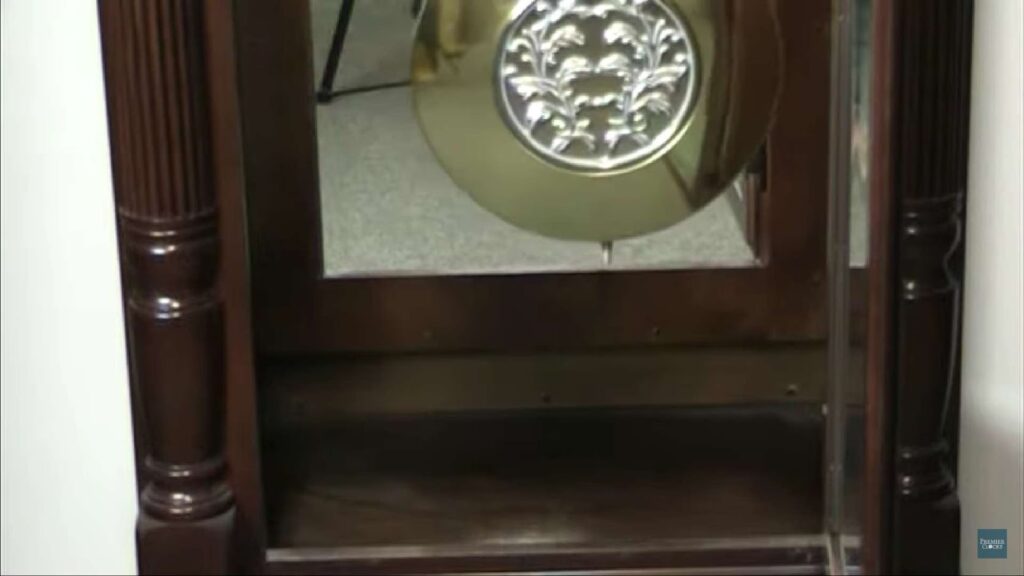The inception of the grandfather clock’s design and aesthetics can be attributed to the introduction of the pendulum. This pendulum, a suspended object tethered to a fixed point, gracefully oscillates to and fro under the influence of gravity. Christian Huygens, a visionary of his time, conceived a novel approach harnessing the potential of it to aid clockmakers in their craft. His ingenious notion sought to revolutionize the conventional means of powering clocks, which relied on springs and weights. Instead, Huygens proposed a groundbreaking concept where it would rhythmically swing each second, synchronized through the innovative anchor escapement system. This groundbreaking formula necessitated the adoption of longer pendulums to achieve precision and accuracy.
Setting Up the Pendulum in a Grandfather Clock
Preparing the Pendulum:
Upon unboxing, one might find a protective layer, typically made of colored plastic, safeguarding the disc’s surface. This film serves to shield it from potential scratches, dust, or other contaminants during storage or transportation. It’s essential to gently peel off this layer, ensuring that it remains pristine and unscathed.
Locating the Guide:
The guide is a crucial component that holds it in place and allows for its uninterrupted movement. To find this, one should inspect the grandfather clock’s front door. If not visible there, the guide may also be accessed through alternative points, such as side or back panels of the clock. The position may vary based on the clock’s design.
Inserting:
With a steady hand, hold onto the guide to keep it stable. Simultaneously, introduce it into the clock’s interior through the front door. It’s essential to ensure that it doesn’t come into rough contact with any parts of the clock during this process to avoid damage or misalignment.
Securing in Place:
At the top, there is a hook. This hook is designed to fit into a specific slot on the guide. Carefully align the hook with this slot, and then gently lower it. This action will ensure it’s suspended appropriately and securely from the guide. Once correctly positioned, it should swing freely without obstruction.
Fine-Tuning Time Precision
Understanding Adjustments:
The accuracy of many traditional clocks depends on the precise positioning of the disk. Adjusting this can regulate the speed at which the clock counts time. When one wishes to alter the speed of timekeeping, it’s crucial to adjust the disk’s position:
- Raising the Disk: This will make the clock tick faster. Turn the adjustment nut clockwise;
- Lowering the Disk: To slow the timekeeping pace, lower it. Rotate the adjustment nut counterclockwise.
A Structured Approach to Timekeeping Precision:
Day One: Establishing a Baseline:
- Choose an Optimal Time for Calibration: Select a specific time of day for calibration over at least six days and note it;
- Determine the Exact Current Time: Use reliable sources such as atomic clocks or official timekeeping websites;
- Synchronize the Clock: Adjust the minute hand to match the precise current time.
Day Two to Day Six: Refinement and Calibration:
- Verification of Time: Check the accurate time daily from a reliable source;
- Comparison and Analysis: Evaluate any discrepancies in timekeeping between your clock and the exact time.
Making Adjustments:
- If there’s a time discrepancy, turn the adjustment nut accordingly. A full rotation typically affects timekeeping speed by about half a minute over 24 hours. However, the exact adjustment can vary based on specific design and characteristics;
- Recheck and Recalibrate: After adjustments, verify the time.
Final Reset: Adjust your clock’s minute hand back to the accurate time.
Through this methodical approach, one can ensure the precision and accuracy of timekeeping on traditional clocks. This routine guarantees reliable results whether for personal satisfaction or preserving a historical piece.
Conclusion:
Ensuring the correct installation of the pendulum is essential to ensure the grandfather clock functions accurately and seamlessly. By adhering to these meticulous instructions, you will not only maintain the clock’s structural integrity but also secure its durability and precision in timekeeping.
